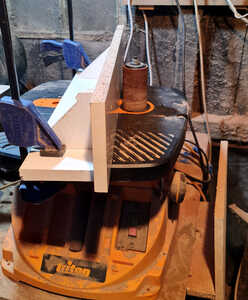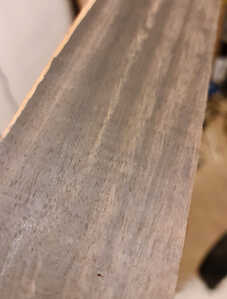Erm not exactly but I seen it the toobs and thought I'd try, not totally convinced though. They make it look easy to get a perfect finish on the toobs but I've still got slight ripples.
Erm, not sure I'd even both trying that. You'd have to be so careful and consistent with the pressure against the up-and-downer, and the speed at which you pass the board past it. I'd expect the outcome to be more rippled than smooth.
As Mark has said (I believe), you *could* make a guitar with little more than a screwdriver. But life's a lot easier (and the results of a job much more predictable) if you use the right tool for the job.
For that job, either a planer/thicknesser, or (if you've not got a thicknesser or the material is too big to fit) a surfacing bit and a router jig.
Online guitar making courses – guitarmaking.co.uk
me, think I'll just use the no7 handplane lol
Yup No 5 for a fretboard for me. Thickness it, Make it straight, cut the fretslots. Then, setup the hand plane for smoothing, and take a pass on both outer edges of the fretboard, repeat, and take a pass a little more inwards, repeat until you reach the middle line, but leave the middle line untouched. Make sure you gradually move both left and right sides in the same size strokes. Check with your radius gauge. Repeat the whole process until you get the radius you want, install the dot markers and sand flush. Minimal sanding needed that way.
I always make the radius before I cut the fret slots as I find using a plane can chip at the slots.
It should not chip if the blade is sharp enough, but yes, it is always possible and a good solution to mitigate the possibility of tear out 👍
So ideal order: plane to thickness, radius with plane, slots, dot markers, sand flush. ( or leave out the plane and just use a sanding beam 😀 )
I have a drum sander to tackle the thickness (and flatness) of fretboards. It takes a few passes but there is no risk for tearout. Then I cut the fret slots. I make the radius using a router bit, usually with a 12" radius, on the router table. I feared that this step could cause tearout at the fret slots, but no problems yet. Maybe due to the router bits still beeing sharp and shiny.
But I haven't done more than a few fretboards, so time will tell, I guess.
I am really struggling with hand planing, so I practise that on cheaper wood. 🙂
@swepri oh god yeh, I know exactly what you mean! Lol
I find my big stanley no 7 really haleps with that, I find that difficult with smaller planes unless it's a big flat board. Like a guitar top, I can flatten that right out with the no 4 but for joiing body blanks and such, it has to be the no 7 for me. Just tilt the blade slightly then run across a couple of times and done.
A lot of people set up a shooting board but I haven't got the hang of that yet, also my space isn't set up right to use it properly.




